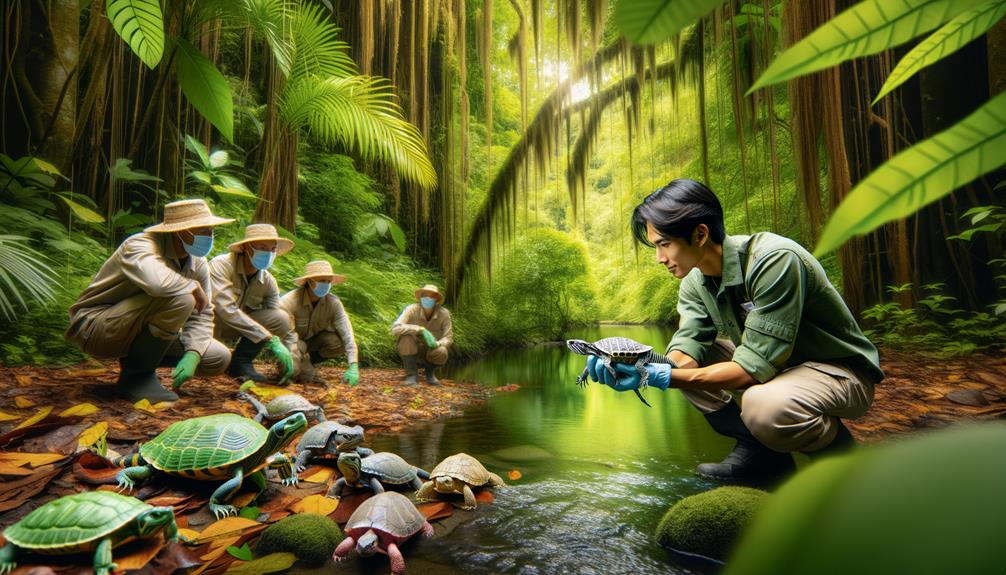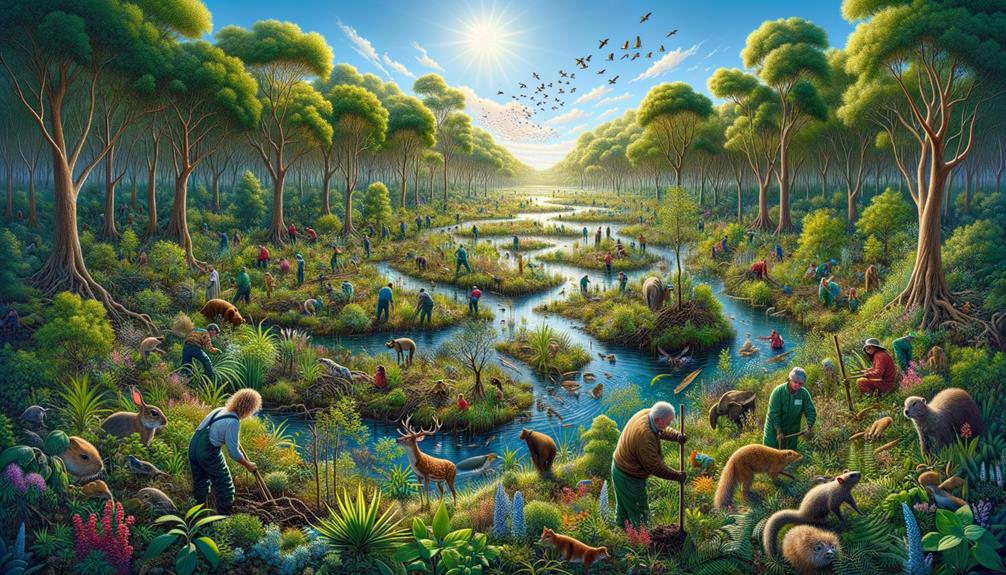I'm deeply passionate about international reptile conservation collaborations, which bring together experts to protect diverse reptile species worldwide. The IUCN Iguana and Crocodile Specialist Groups, for instance, develop critical action plans to address pressing threats. The Turtle Survival Alliance's extensive work in 35 countries is remarkable, driving science-based strategies that make a real difference. Their projects, such as restoring 10,000 acres of wetlands and monitoring 10,000 snakes in Indonesia, demonstrate the significant biodiversity impact of these collaborations. By training over 1,000 personnel on humane practices, we can ensure a sustainable reptile skin trade. These efforts are crucial for preserving our planet's reptile biodiversity. Let's take a closer look at the collaborations that make these achievements possible.
Key Takeaways
Conservation efforts are underway to protect iguanas and crocodiles worldwide, with IUCN Specialist Groups developing action plans to address their declining populations.
The Turtle Survival Alliance is working in over 35 countries to implement effective conservation strategies and protect these species.
Through international collaboration, more than 10,000 acres of habitats have been restored, providing a safe haven for reptiles to thrive.
SARCA's innovative app enables efficient reptile population monitoring, helping conservationists make informed decisions to protect these species.
Stakeholder engagement is crucial in ensuring humane and sustainable practices in the reptile skin trade, promoting a responsible and environmentally-friendly industry.
Global Reptile Conservation Initiatives
Global reptile conservation initiatives, such as those led by the IUCN Iguana Specialist Group and Crocodile Specialist Group, play a vital role in assessing the conservation status and developing targeted action plans to protect endangered reptile species. These groups thoroughly examine the threats facing iguanas and crocodiles, including habitat loss and illegal trade, and develop precise strategies to mitigate these risks.
The Turtle Survival Alliance is a standout in amphibian and reptile conservation. By partnering with organizations in over 35 countries, they implement science-based conservation strategies to rescue imperiled turtle and tortoise populations. This collaborative effort demonstrates the power of data-driven conservation in safeguarding vulnerable species.
The International Herpetological Symposium provides a platform for researchers, conservationists, and reptile enthusiasts to share breakthroughs and best practices. This exchange of knowledge is crucial for refining conservation techniques and adapting to emerging challenges.
Without global initiatives like these, the future of many reptile species would be uncertain. These efforts highlight the need for a unified, informed approach to conservation, ensuring the preservation of amphibian and reptile biodiversity for future generations.
Key Collaborative Projects
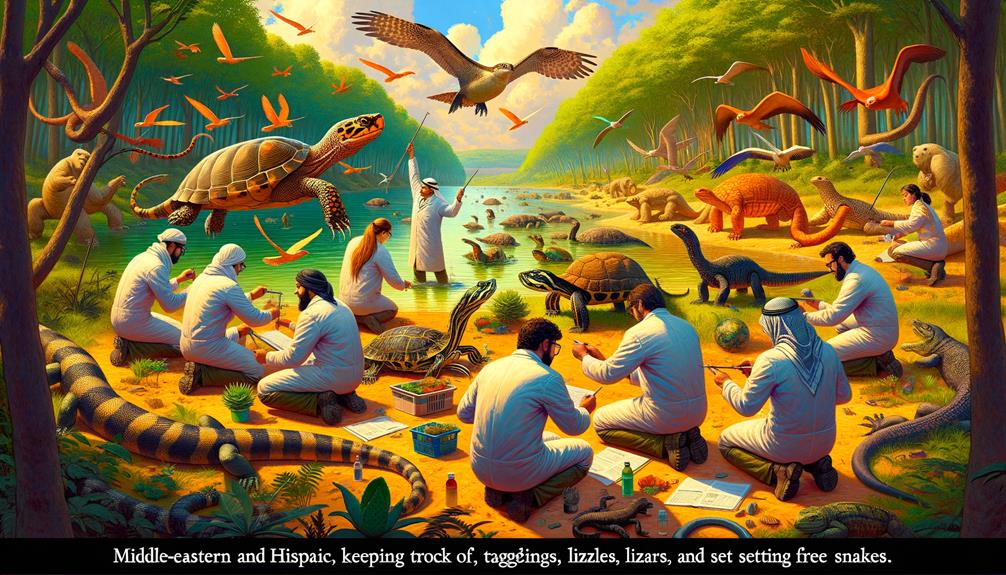
I'm excited to share some notable collaborative projects that are making a real difference in reptile conservation. SARCA's work in habitat restoration and species monitoring is significant, particularly in Southeast Asia, where they've trained over 1,000 personnel on humane practices and developed a digital app for population monitoring. These initiatives not only advance our understanding of reptiles but also ensure sustainable and responsible reptile trade, aligning with critical Sustainable Development Goals.
Habitat Restoration Efforts
PARC's collaborative habitat restoration projects have significantly improved critical wetland, grassland, and forest ecosystems, providing vital refuges for diverse amphibian and reptile species. With over 10,000 acres restored across the U.S., these efforts by conservation organizations like PARC are making a substantial impact.
The Mexico-US PARC Binational Initiative has reintroduced native vegetation on 75 miles of degraded borderlands, creating vital habitats for herpetofauna. In the Southeast, collaborations with state agencies and private landowners have transformed over 8,000 acres of longleaf pine forests, offering a safe haven to gopher tortoises and other reptiles.
| Region | Project Description |
|---|---|
| United States | 10,000 acres of wetlands, grasslands, forests |
| Mexico-US | 75 miles of borderlands restored |
| Southeast US | 8,000 acres of longleaf pine forests enhanced |
Furthermore, habitat restoration grants have led to the creation of 200 new breeding ponds for amphibians like the Crawfish Frog and California Tiger Salamander. In the Western U.S., the Regional Working Groups' efforts have removed 3,500 acres of invasive plants and reintroduced native species, revitalizing habitats for reptiles and amphibians alike. These initiatives demonstrate that collaborative efforts can help reclaim and preserve the wild spaces essential for the survival of these remarkable creatures.
Species Monitoring Programs
Diving into the world of species monitoring programs, SARCA's projects have transformed how we track and protect reptile populations globally. By developing a digital data collection app, SARCA has enabled state and federal agencies, along with scientific networks, to conduct efficient annual population monitoring. This app is a vital tool, allowing for real-time data collection that informs decision-making.
Take, for example, the two-year field study in Indonesia. Led by local experts, this project examined over 10,000 snakes from 20 species, providing invaluable insights that advance our scientific understanding and highlight conservation needs. These efforts are crucial for achieving Sustainable Development Goals 12 and 15, focusing on responsible consumption, production, and life on land.
SARCA's work goes beyond data collection. The information gathered supports policy decisions and management strategies, ensuring the sustainability of reptile and amphibian populations. By understanding the dynamics of reptile skin sourcing, SARCA addresses broader environmental and ethical concerns. Their dedication to monitoring programs demonstrates a commitment to conservation that is both passionate and effective. Through these initiatives, we're not just preserving species; we're working towards a future where biodiversity flourishes.
Stakeholder Engagement Strategies
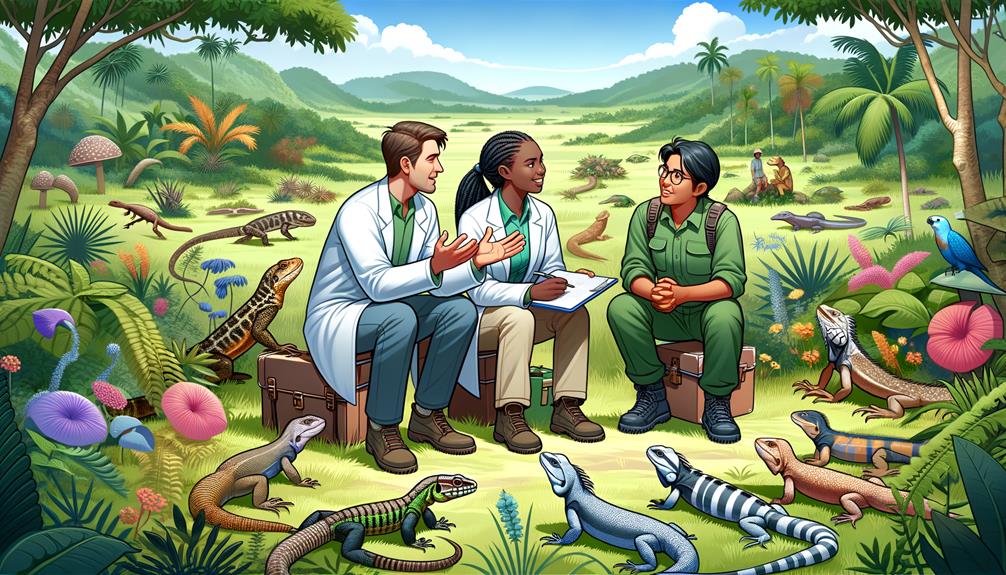
To effectively engage stakeholders and ensure sustainable and humane practices in the reptile skin supply chain, organizations like SARCA play a vital role in bringing together diverse stakeholders, including reptile processing facilities, farms, local communities, NGOs, and government agencies. By facilitating open dialogues, we can identify and address key challenges and opportunities in reptile conservation and livelihoods.
Our approach involves comprehensive training programs, which have educated over 1,000 personnel in Southeast Asia on humane practices such as proper capture, transport, and euthanasia of reptiles. This hands-on approach aligns the interests of all parties involved and builds trust, essential for collective action. We strive to create a shared vision where every stakeholder feels responsible and invested in the outcome.
Furthermore, SARCA supports population monitoring by funding digital data collection tools, enabling government authorities and scientific networks to make informed decisions. By working together, we can ensure the reptile skin trade is not only sustainable and fair but also humane. Through these collaborative efforts, we can safeguard the future of reptile conservation.
Research and Monitoring Efforts
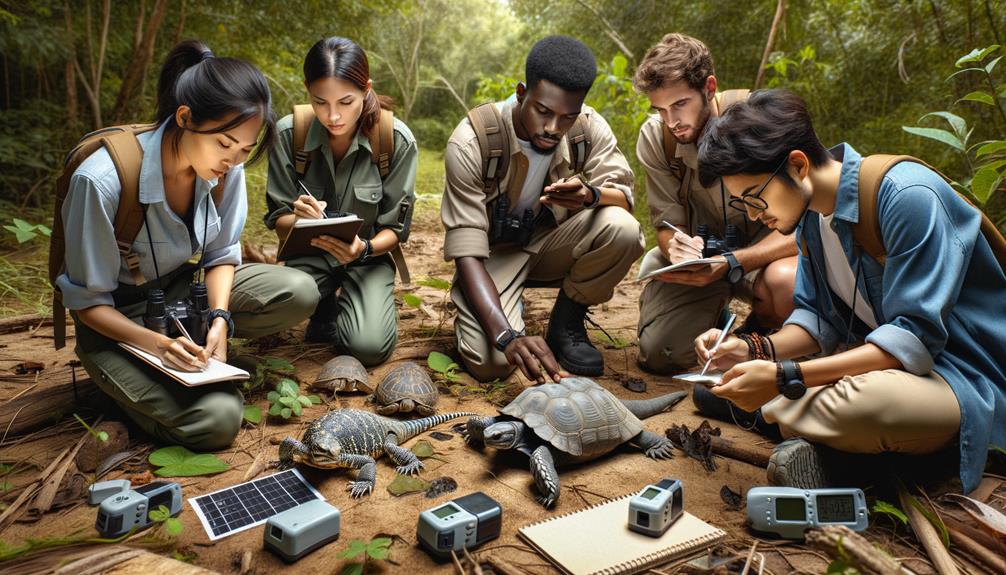
When I consider our research and monitoring efforts, understanding population trends and habitat health is crucial. Our study of over 10,000 snakes in Indonesia has provided valuable insights into species populations and ecosystem stability. This data informs sustainable management strategies and supports global biodiversity goals.
Tracking Population Trends
Tracking population trends is crucial for understanding the health and stability of reptile species. SARCA's research and monitoring efforts have made significant progress in this area. By focusing on individual species and their unique ecosystems, we can better comprehend and conserve amphibians and reptiles. For instance, a two-year field study in Indonesia, funded by SARCA, examined over 10,000 snakes across 20 species. This project substantially advanced our scientific understanding, providing valuable data on population dynamics.
SARCA has developed a digital data collection application, empowering government authorities and scientific networks to conduct accurate annual population monitoring. This approach ensures that reptile populations not only survive but thrive in the wild. Our efforts contribute significantly to achieving Sustainable Development Goal 15, promoting life on land and the conservation of reptile species.
Our initiatives have several key impacts:
- Deeper understanding: We've gained valuable insights into reptile population trends.
- Effective monitoring tools: Government authorities and scientists now have the means to conduct precise annual monitoring.
- Responsible sourcing: Our research informs the development of sustainable reptile skin trade practices.
- Global conservation: Our work aligns with SDG 15 goals, promoting life on land and reptile species conservation.
These efforts reflect our passion for protecting the freedom and vitality of reptile species worldwide.
Habitat Health Assessments
Building on our in-depth understanding of population trends, we're shifting our focus to habitat health, a crucial aspect of effective reptile conservation. Habitat health assessments provide valuable insights into the environmental conditions that support thriving reptile populations. Through SARCA's extensive research efforts, we've funded field studies in Indonesia, examining over 10,000 snakes from 20 species. This data has significantly advanced our scientific understanding and informed our conservation strategies.
In our research laboratories, we analyze this wealth of data to evaluate habitat quality, identify threats, and develop strategies to address them. SARCA's digital data collection application has streamlined annual population monitoring, allowing government authorities and scientific networks to gather and share data efficiently. This collaboration ensures that our habitat health assessments are comprehensive and up-to-date.
Our goal is clear: to maintain healthy, sustainable wild reptile populations with regulated harvesting. By supporting robust data collection and analysis, we contribute to evidence-based decision-making, ultimately fostering a world where reptiles thrive in their natural habitats. Every piece of data, every field study, and every analysis brings us closer to achieving this vision.
Sustainable Trade Practices
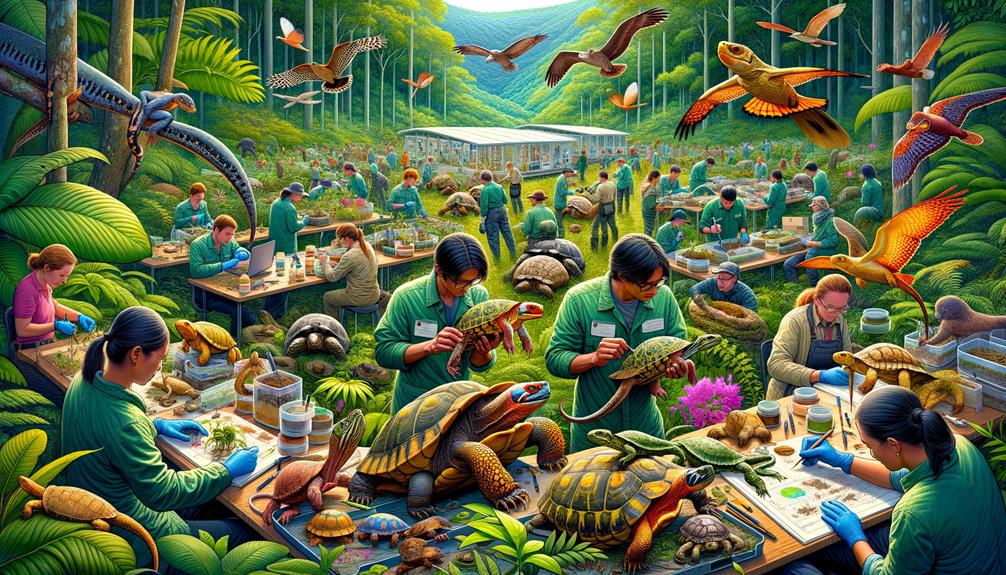
In the realm of sustainable trade practices, SARCA's initiatives demonstrate how a well-designed framework can balance economic interests with ecological and ethical imperatives. Their Responsible Reptile Sourcing Standard sets a high bar for the pet trade industry and nature centers, highlighting the need for a balance between commerce and conservation.
SARCA's efforts go beyond theory; they've trained over 1,000 reptile skin supply chain personnel in Southeast Asia. This training ensures that humane methods are used for capture, transport, keeping, and euthanizing reptiles. It's about fostering respect for these creatures.
SARCA has funded a digital data collection application that supports annual population monitoring by government authorities and scientific networks. This monitoring enables data-driven decisions that sustain wild reptile populations. The tag traceability system provides industry-wide chain of custody, promoting transparency and accountability.
Consider these achievements:
- Over 1,000 personnel have received training in humane reptile handling.
- A two-year field study in Indonesia has focused on 20 species.
- Digital tools support robust population monitoring.
- Tag traceability ensures ethical supply chains.
These accomplishments underscore the importance of SARCA's work in promoting sustainable trade practices.
Success Stories and Case Studies
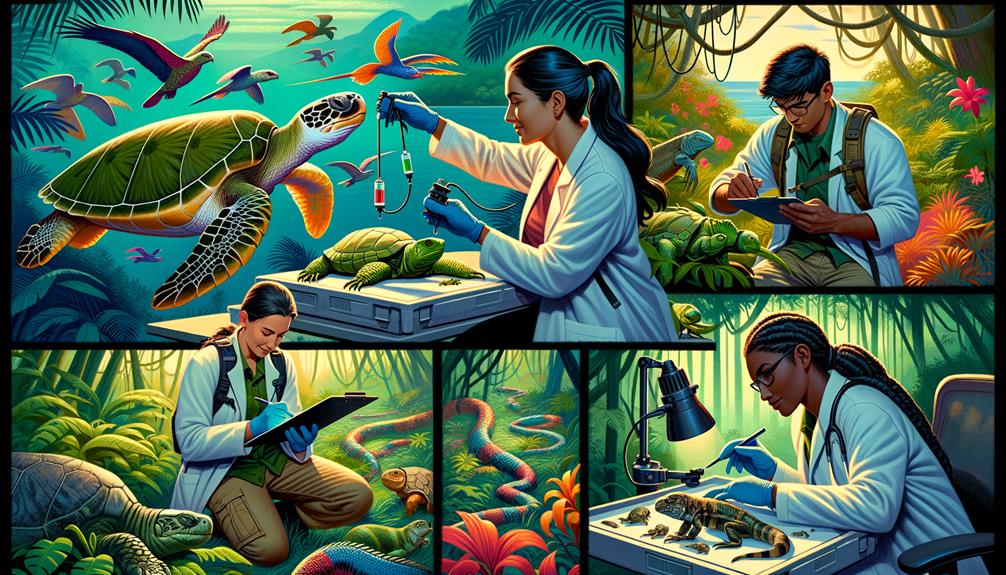
Let's explore some inspiring stories of international collaborations that have made a significant impact on reptile conservation. The Sipalawini Gecko Conservation Project in Suriname is a great example. By focusing on habitat restoration and community engagement, this initiative has stabilized populations of the critically endangered gecko. Herpetological organizations and environmental consultants worked together to achieve this remarkable outcome.
In Jamaica, collaborative efforts to reintroduce the Jamaican Iguana have transformed its fate. From just 50 individuals in the 1990s, their population now exceeds 500, thanks to dedicated partnerships. The Iguana Conservation Fund has been instrumental in supporting research and protection for several threatened West Indian iguana species, resulting in improved conservation statuses.
The Galápagos Land Iguana's resurgence is another testament to the power of multinational partnerships. Once dwindling to just 8,000 in the 1970s, their numbers have soared to over 20,000 today. The Lake Titicaca Frog Conservation Initiative showcases the effectiveness of global cooperation in safeguarding unique amphibians. This program has brought the species back from the brink of extinction, highlighting the importance of united efforts in herpetological conservation.
Frequently Asked Questions
What Does the International Reptile Conservation Foundation Do?
Over 50% of reptile species are facing extinction. As the International Reptile Conservation Foundation, our mission is to protect these incredible creatures by restoring their habitats, monitoring their populations, and engaging with local communities. We're dedicated to ensuring the survival of these often-overlooked animals.
What Is the Conservation Status of the World's Reptiles?
The world's reptiles are in a precarious state. Habitat destruction, climate change, and poaching threaten their very existence. It's crucial we take immediate action to protect their freedom and biodiversity for future generations.
What Is the Amphibian and Reptile Conservation Area in Southeast Iowa?
I once stumbled upon an ornate box turtle thriving in Southeast Iowa's Amphibian and Reptile Conservation Area. This protected haven spans 2,000 acres of wetland, prairie, and woodland, providing critical habitats for threatened species and driving community-led conservation initiatives.
What Is Amphibian and Reptile Conservation Wales?
Amphibian and Reptile Conservation Wales (ARC Wales) is dedicated to protecting herpetofauna in Wales by monitoring habitats, conducting research, and educating the public. The organization works with various groups to develop and implement effective conservation initiatives across the region.


